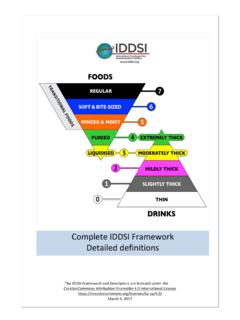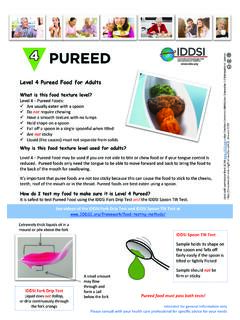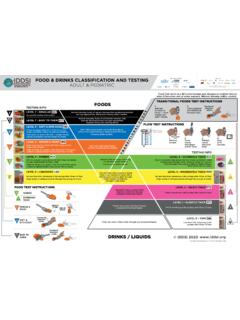Transcription of IDDSI Framework Testing Methods 2.0 | 2019
1 This IDDSI Framework and Descriptors are licensed under the CreativeCommons Attribution-Sharealike International License IDDSI |July 2019 IDDSI Framework Testing Methods | 2019 The IDDSI Framework and Descriptors are licensed under the CreativeCommons Attribution-Sharealike International License IDDSI | July 2019 2 INTRODUCTION The International Dysphagia Diet Standardisation Initiative ( IDDSI ) was founded in 2013 with the goal of developing new international standardised terminology and definitions to describe texture modified foods and thickened liquids used for individuals with dysphagia of all ages, in all care settings, and all cultures. Three years of work by the International Dysphagia Diet Standardisation Committee culminated in the 2016 release and 2017 publication of the IDDSI Framework consisting of a continuum of 8 levels (0-7) Levels are identified by numbers, text labels and colour codes.
2 [Reference: Cichero JAY, Lam P, Steele CM, Hanson B, Chen J, Dantas RO, Duivestein J, Kayashita J, Lecko C, Murray J, Pillay M, Riquelme L, Stanschus S. (2017) Development of international terminology and definitions for texture-modified foods and thickened fluids used in dysphagia management: The IDDSI Framework . Dysphagia, 32:293-314. ] The IDDSI Framework Testing Methods 2019 is an update to the 2016 document and provides details regarding Testing Methods for use with the IDDSI Framework . This document is to be read in conjunction with the Complete IDDSI Framework 2019, IDDSI Evidence 2016 and IDDSI Frequently Asked Questions (FAQs) documents ( ). The IDDSI Framework provides a common terminology to describe food textures and drink thickness. IDDSI tests are intended to confirm the flow or textural characteristics of a particular product at the time of Testing .
3 Testing should be done on foods and drinks under the intended serving conditions (especially temperature). The clinician has the responsibility to make recommendations for foods or drinks for a particular patient based on their comprehensive clinical assessment. IDDSI would like to acknowledge the interest and participation of the global community including patients, caregivers, health professionals, industry, professional associations and researchers. We would also like to thank our sponsors for their generous support. Please visit for further information. The IDDSI Board: The IDDSI Board are a group of volunteers who do not draw a salary from IDDSI . They offer their knowledge, expertise and time for the benefit of the international community. Co-Chairs: Peter Lam (CAN) & Julie Cichero (AUS); Board Members: Jianshe Chen (CHN), Roberto Dantas (BRA), Janice Duivestein (CAN), Ben Hanson (UK), Jun Kayashita (JPN), Mershen Pillay (ZAF), Luis Riquelme (USA), Catriona Steele (CAN), Jan Vanderwegen (BE).
4 Past Board Members: Joseph Murray (USA), Caroline Lecko (UK), Soenke Stanschus (GER) The International Dysphagia Diet Standardisation Initiative Inc. ( IDDSI ) is independent and operates as a not-for-profit entity. IDDSI is grateful to a large number of agencies, organizations and industry partners for financial and other support. Sponsors have not been involved with the design or development of the IDDSI Framework . Implementation of the IDDSI Framework is in progress. IDDSI is extremely grateful to all sponsors supporting implementation The IDDSI Framework and Descriptors are licensed under the CreativeCommons Attribution-Sharealike International License IDDSI | July 2019 3 The IDDSI systematic review suggested that liquids and food should be classified in the context of the physiological processes involved in oral processing, oral transport and flow initiation (Steele et al.)
5 , 2015). To this end, different devices are needed to best describe the behaviour of the bolus. Drinks and other liquids Accurate measurement of fluid flow properties is a complex task. To date, both research and existing national terminologies, have studied or recommended the classification of drinks based on viscosity. However, viscosity measurement is not accessible to most clinicians or caregivers. Furthermore, viscosity is not the only relevant parameter: the flow of a drink as it is consumed is influenced by many other variables including density, yield stress, temperature, propulsion pressure and fat content (O Leary et al., 2010; Sopade et al., 2007, Sopade et al., 2008a,b; Hadde et ,b). The systematic review demonstrated wide variability in Testing techniques used and found that other key parameters such as shear rates, sample temperature, density and yield stress were rarely reported (Steele et al.
6 , 2015; Cichero et al., 2013). Drinks thickened with different thickening agents may have the same measurement of apparent viscosity at one particular shear rate, and yet have very different flow characteristics in practice (Steele et al. 2015; O Leary et al.,2010; Funami et al., 2012; Ashida et al., 2007; Garcia et al., 2005). In addition to variations in flow associated with drink characteristics, flow rates during swallowing are expected to differ depending on a person s age and level of impairment of swallowing function (O Leary et al., 2010). For these reasons, a measurement of viscosity has not been included in the IDDSI descriptors. Instead, a gravity flow test using a 10 mL slip tip syringe is recommended to quantify the liquid s flow category (sample remaining from 10 mL after 10 sec of flow). The controlled conditions are broadly representative of the way a liquid moves when swallowed, such as flow through a syringe or funnel.
7 The IDDSI Flow test is also similar in design and measurement principles to the Posthumus Funnel that is used in the dairy industry to measure liquid thickness (van Vliet, 2002; Kutter et al., 2011). In fact the Posthumus funnel looks like a large syringe (van Vliet, 2002; Kutter et al., 2011). Measures taken using the Posthumus funnel include the time for a specified amount of sample to flow, and mass left after a defined period of flow. Van Vliet (2002) notes that the geometry of the Posthumus funnel contains a shear and elongation component that more closely matches flow conditions within the oral cavity (Hanson et al., 2019). Although the syringe chosen for use with the IDDSI Flow test is simple , the test has been found to categorise a wide range of liquids reliably, and in agreement with currently existing laboratory tests and expert judgement (Hanson et al.)
8 , 2019). It has also been found to be sensitive enough to demonstrate small changes in thickness associated with change in serving temperature. Testing Methods for use with the IDDSI Framework The IDDSI Framework and Descriptors are licensed under the CreativeCommons Attribution-Sharealike International License IDDSI | July 2019 4 IDDSI Flow Test The IDDSI Flow test uses a 10 mL slip tip hypodermic syringe, as shown in the image below. Although 10 mL syringes were initially thought to be identical throughout the world based on reference to an ISO standard (ISO 7886-1), it has subsequently been determined that the ISO document refers only to the nozzle of the syringe and that variability in barrel length and dimensions may exist between brands. Specifically, the IDDSI Flow test uses a reference syringe with a measured length of mm from the zero line to the 10 mL line (BDTM syringes were used for the development of the tests manufacturer code North America 303134, Australia 302143).
9 IDDSI is aware that there are some syringes that are labeled as 10 mL but have different dimensions or in fact have a 12 mL capacity. Using a syringe of different dimensions to that described here or a 12 mL syringe will give results that cannot reliably be used with the IDDSI Framework . As a result, it is important to check the barrel length as shown on the diagram on page 5. Details for conducting the test are shown below. In the near future funnels that have been specifically designed for IDDSI Testing may be available. Videos showing the IDDSI Flow Test can also be viewed at: Testing tips: When using commercial thickener products, follow the manufacturer s instructions and mix thoroughly, watching closely that there are no lumps or air bubbles present. Be sure to allow the recommended time for the fluid to thicken completely. Use a clean, dry syringe of the correct type each time you test.
10 Check the nozzle of the syringe is completely clear and free from any plastic residue or manufacturing defects that may occasionally occur. Test twice or more to ensure more reliable results. Check for lumps especially if flow suddenly stops. In this case the fluid may not be suitable for dysphagia use. Ensure to test the liquid at the intended serving temperature NOTE: Drinks and liquids such as gravy, sauces and nutritional supplements are best assessed using the IDDSI Flow Test (Levels 0-3). Note that all products should be thoroughly stirred as non-homogenous liquids may give inconsistent results. Foams found in carbonated drinks may appear thick on the flow test as they are less liable to flow under their own weight, as their density is lower. Foams may also be unstable over time and release thinner liquids as the carbonated bubbles burst.












